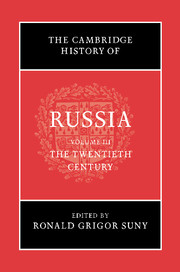Book contents
- Frontmatter
- Introduction
- 1 Reading Russia and the Soviet Union in the twentieth century: how the ‘West’ wrote its history of the USSR
- Part I Russia and the Soviet Union: The Story through Time
- 2 Russia’s fin de siècle, 1900–1914
- 3 The First World War, 1914–1918
- 4 The revolutions of 1917–1918
- 5 The Russian civil war, 1917–1922
- 6 Building a new state and society: NEP, 1921–1928
- 7 Stalinism, 1928–1940
- 8 Patriotic War, 1941–1945
- 9 Stalin and his circle
- 10 The Khrushchev period, 1953–1964
- 11 The Brezhnev era
- 12 The Gorbachev era
- 13 The Russian Federation
- Part II Russia and the Soviet Union: Themes and Trends
- Bibliography
- Index
- References
4 - The revolutions of 1917–1918
from Part I - Russia and the Soviet Union: The Story through Time
Published online by Cambridge University Press: 28 March 2008
- Frontmatter
- Introduction
- 1 Reading Russia and the Soviet Union in the twentieth century: how the ‘West’ wrote its history of the USSR
- Part I Russia and the Soviet Union: The Story through Time
- 2 Russia’s fin de siècle, 1900–1914
- 3 The First World War, 1914–1918
- 4 The revolutions of 1917–1918
- 5 The Russian civil war, 1917–1922
- 6 Building a new state and society: NEP, 1921–1928
- 7 Stalinism, 1928–1940
- 8 Patriotic War, 1941–1945
- 9 Stalin and his circle
- 10 The Khrushchev period, 1953–1964
- 11 The Brezhnev era
- 12 The Gorbachev era
- 13 The Russian Federation
- Part II Russia and the Soviet Union: Themes and Trends
- Bibliography
- Index
- References
Summary
On 23 February 1917 thousands of female textile workers and housewives took to the streets of Petrograd to protest against the bread shortage and to mark International Women’s Day. Their protest occurred against a background of industrial unrest – only the day before, workers at the giant Putilov plant had been locked out – and their demonstration quickly drew in workers, especially in the militant Vyborg district. By the following day, more than 200,000 workers were on strike. The leaders of the revolutionary parties were taken by surprise at the speed with which the protests gathered momentum, but experienced activists, who included Bolsheviks, anti-war Socialist Revolutionaries (SRs) and non-aligned Social Democrats, gave direction to the movement in the working-class districts. By 25 February students and members of the middle classes had joined the crowds in the city centre, singing the Marseillaise, waving red flags and bearing banners proclaiming ‘Down with the War’ and ‘Down with the Tsarist Government’. Soldiers from the garrison proved reluctant to clear the demonstrators from the streets. On Sunday, 26 February, however, they were ordered to fire on the crowds and by the end of the day hundreds had been killed or wounded. The next day proved to be a turning-point. On the morning of 27 February, the Volynskii regiment mutinied and by evening 66,700 soldiers had followed their lead. Demonstrators freed prisoners from the Kresty jail, set fire to police stations, ‘blinded’ portraits of the tsar and ‘roasted’, that is, set alight, the crowned two-headed eagle, symbol of the Romanov dynasty.
- Type
- Chapter
- Information
- The Cambridge History of Russia , pp. 114 - 139Publisher: Cambridge University PressPrint publication year: 2006
References
- 6
- Cited by

